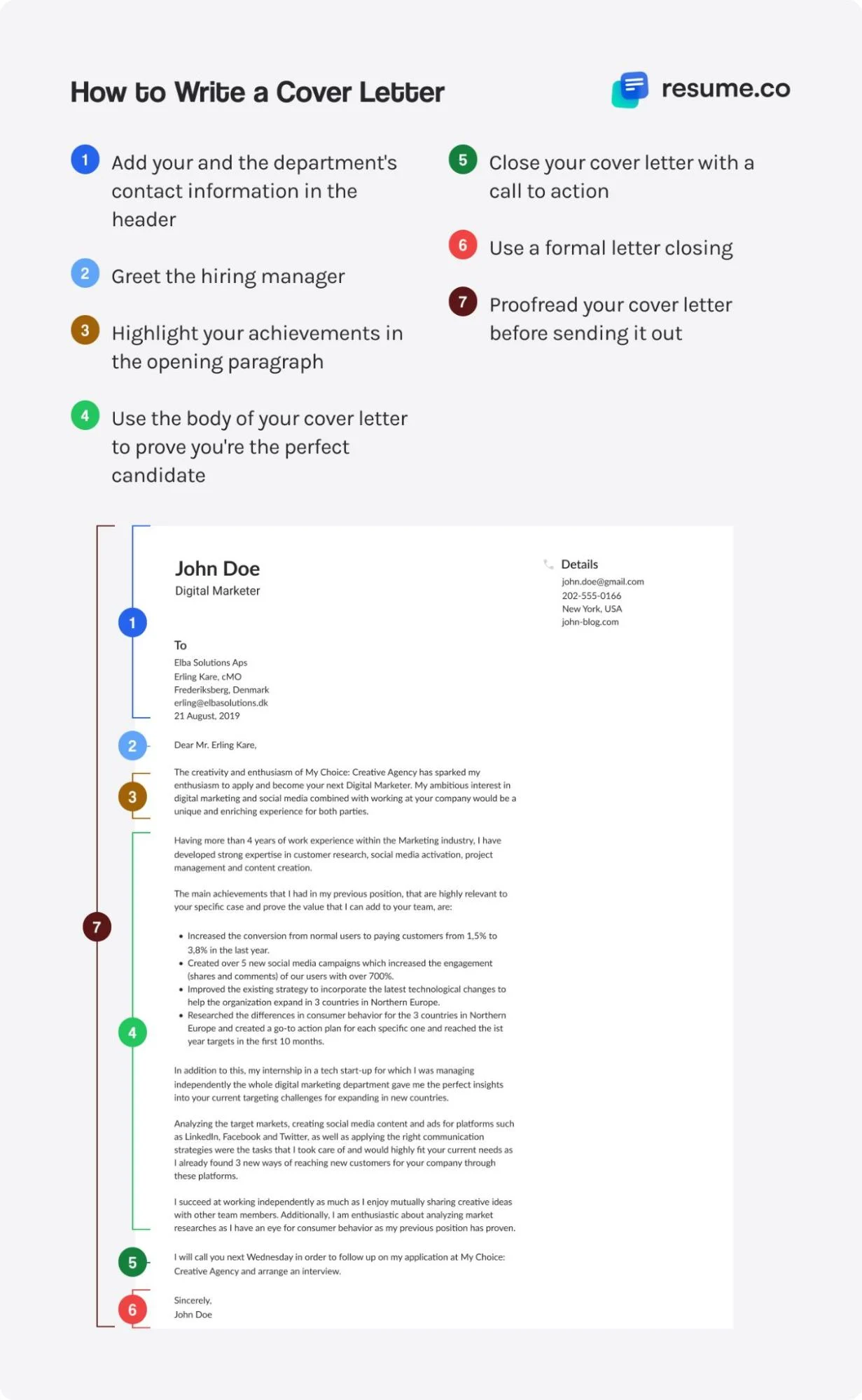Writing a teacher cover letter can feel like grading a stack of essays in the middle of a vivid dodgeball game. There’s a ton of valuable information in your head, yet you need to concisely arrange it all on one page.
However, doing that is a worthwhile endeavor, as this is a chance to convey your passion for teaching and prowess in controlling the classroom to a potential employer. Because of this, we put together a comprehensive article to help you understand the ins and outs of writing a teaching cover letter.
You’ll learn how to show your abilities and dedication to the craft, as well as how to leave a lasting good impression on recruiters, principals, and superintendents. Without further ado, let’s get started!
Key Takeaways
A cover letter should be a one-page document that features your and the recipient’s contact information, a salutation, a strong opening paragraph, the body of a letter, a call to action, and a formal closing.
Use the body of your cover letter to explain what makes you the best candidate for the position by emphasizing your relevant abilities and accomplishments.
Thoroughly proofread your cover letter to correct any potential mistakes and polish it to perfection.
For optimal chances of success, you should write a unique application letter for a teaching job that complements your resume each time you apply for a new role.
Here’s a complete teacher cover letter example to help you get started:
What Format Should You Use for Your Teacher Cover Letter?

Writing a cover letter for a teaching job becomes much easier once you understand that there’s a proven format that you can follow to fit everything neatly on one page. Whether you’re a seasoned candidate or a teacher with no experience writing a cover letter, the format stays the same. Here is what it should look like:
Teacher Cover Letter Format
Contact information should go at the beginning of your education cover letter. It should feature both your and the recipient’s details along with the date of writing.
Formal salutation, where you want to greet the reader, preferably by name.
The opening paragraph represents your chance to make a good first impression right at the start. It should highlight your key strengths in a brief, concise, and impactful manner.
The body of your teacher cover letter is its centerpiece. This is usually the biggest part of your document and the one where you present most of the information to hiring managers.
The final paragraph should feature a call to action.
Formal letter closing with a signature
(Optional) Postscript with a particularly catchy detail that can convince the hiring manager to read your cover letter in case they just skimmed through it.
Here is what that looks like in practice:

How to Write a Teacher Cover Letter: Step-by-Step Guide
Now that we know the structure of your cover letter and what to include, let’s see how to properly write each of its parts.
#1. Add Contact Information in the Header
Contact information should be the first thing recruiters and potential employers see on your cover letter. That’s why you should place it in the header of the document and neatly list the following details:
Mandatory Sections
Your name
Job title
Phone number
Email address
Optionally, you can include:
Optional Sections
Location
Relevant social media profiles (e.g., LinkedIn)
Make sure you’re keeping it professional when adding bits such as your job title and email address. If you’re still using a decade-old, improper email address, it’s time to create one along the lines of “firstname.lastname@email.com.”
Don’t forget to include the date of writing before the school’s details after listing your contact information.
Let’s look at an example of a contact information section for an elementary school teacher cover letter:
Good Example
Nina Hill Teacher 1633 Cherry Camp Road Lombard, IL 60148 773-443-9491 ninahill@example.com linkedin.com/ln/ninahill Dalton, 25/05/2023 Katina Wells Assistant Principal Riverside Elementary School 12465 Warwick Boulevard Newport News, VA 23606
Here are the different ways to present this section on your cover letter for a teacher:
#2. Greet the Hiring Manager
There’s no need to overcomplicate the salutation. A simple “Dear” followed by the name of the recipient is enough to introduce them to the letter. Using their name is important—not only does it show that you did your research, but it also helps build rapport from the get-go.
As a result, this is an easy way to score bonus points with hiring managers. Plus, this bit acts as a transition from the orderly contact information section to the more personal and creative content of your document.
#3. Hook Them in the Introduction
The introductory paragraph of a cover letter for a teacher represents an elevator pitch. In essence, you should use these couple of sentences to highlight your motivation and prowess. You should also make sure to mention the institution’s name in order to show that you made an effort to write a personalized letter.
Furthermore, you should include a couple of your key strengths to emphasize how you can contribute to the organization that you’re applying to. That way, you’ll grab the recruiter’s attention and get them to read the rest of your teacher cover letter. Let’s take a look at a well-written example:
Good Example
As a seasoned high school teacher, I am thrilled to apply for a position as a physics teacher at [School Name]. My previous endeavors working as a ninth-grade tutor at [Previous School Name] made me confident I could use my knowledge and expertise to help your students achieve academic success.
#4. Elaborate on Why You’re the Right Fit
Once you have the reader’s attention, it’s time to show them what makes you the right fit for their organization, and you can use the body of your cover letter for that. This part should be 1–3 paragraphs long and feature information you haven’t already included in your teacher resume.
Instead of repeating what you already stated in your resume, you should use this section to convey additional valuable information to potential employers. If you’re an experienced teacher writing a cover letter, include a couple of your most prominent achievements and results. You can use numbers to quantify them, further adding credibility to your letter.
Then, you want to mention the key hard and soft skills that are relevant to the position that you’re applying for. That’s yet another way to demonstrate how their organization can benefit from hiring you.
On a final note, you can strengthen your case further by showing your desire and motivation to work with them in particular. You can do that by praising their approach to teaching, focusing on the values that you share with them, pointing out similar goals, and so on.
#5. Add a Call to Action
The most impactful way to finish a cover letter is to add a call to action. This marketing term is used to label something designed to incite an immediate reaction. In your case, you want your potential employer to contact you for further discussion.
In one brief paragraph, you want to thank the reader for their attention and invite them to reach out by expressing your interest in hearing from them. If you're applying for a position at a middle school, for example, it's helpful to directly address the middle school principal or hiring team and express your enthusiasm for contributing to their school's mission.
#6. Write a Formal Closing
Similarly to the greeting in your teacher cover letter, a formal closing needs to be concise and to the point. It’s generally enough to use “Sincerely” or “Yours sincerely” followed by your name to end the letter. Here is an example:
Good Example
Sincerely, Nina Hill
On a final note, you can add a postscript at the bottom of your cover letter for a teacher job. Make sure it features a valuable piece of information or a strong call to action since this part grabs attention and recruiters will likely read it even if they skim through the rest of the document.
#7. Proofread the Cover Letter
After you’re done writing your teacher cover letter, you should thoroughly proofread it. Even a simple typographical error draws the wrong kind of attention, let alone a grammatical mistake or a linguistic mishap.
Moreover, by proofreading your cover letter, you can check whether you need to trim some bits or expand on others. As a rule of thumb, a cover letter should be 250–400 words long. If it’s too short, you miss out on an opportunity to demonstrate your competence; if you make it too long, you can lose the recruiter’s interest before they finish reading.
Finally, it’s important to ensure your resume isn’t too formal but also not completely informal. A fine balance of professionalism and personality can go a long way with potential employers. You want to show that you’ll be a good fit for their team by talking about your skills and experience without coming off as a show-off.
5 Pro Teacher Cover Letter Writing Tips

Whether you want to write a middle school application letter for a teacher or a university professor cover letter, these expert tips will help you make it spotless:
Teacher Cover Letter Writing Tips
For the greatest chances of success, you should write a new, tailored teacher cover letter every time you apply for a new position. That will allow you to include position-specific skills and achievements in the optimal way. Plus, recruiters will appreciate that you went the extra mile and not reused a previously-written cover letter.
Think of your cover letter as an extension of your resume. Use it to strengthen your case and show recruiters and potential employers fresh information instead of writing two similar documents and recycling content.
Check to see if employers provided any kind of instructions regarding cover letters. If there are specific rules and guidelines to follow, then you should ensure you’ve complied with all the directions.
While your cover letter needs to highlight your qualities, make sure you don’t focus on yourself too much and instead show how your employers can benefit from your competence. Subtly convince them that it’s in their interest to hire you, and they’ll be much more likely to call you for an interview.
A postscript usually draws attention, which is why you want it to convey some of the most valuable information about you. Even if recruiters skim through your entire cover letter, they’ll likely read this part. That means a postscript represents one more chance to pique the reader’s interest and convince them to circle back and read everything.
Closing Thoughts
As we reach the end of our journey through the world of teacher cover letters, remember that this document is not only about your qualifications but also your personality. Use it to highlight not just your mastery of the curriculum but also your passion for the craft and motivation to better the lives of your students.
So, as you’re pondering which skills and accomplishments to include to impress your future employers, don’t forget to let a bit of your unique style shine through. Keep calm, teach on, and may your cover letters be as brilliant as your students!
Related Articles
Teacher Assistant Resume Example & Writing Guide
Academic Advisor Cover Letter & Writing Guide
11 Best Jobs For English Majors [w/ Salaries and Job Outlooks]


